Topics
Category
Era
State Grange of Minnesota
Minnesota State Grange picnic held on the Sletton Farm in Aitkin on June 13, 2015. Shown are members of Sunbeam Grange #2, Oak Leaf Grange #569, Clear Lake Grange #692, Lake Hubert Grange #735, and Oliver Hudson Kelley Grange #834. Photographed by Alan Champion.
For almost 150 years, the State Grange of Minnesota as an organization has thrived, faded, and regrouped in its efforts to provide farmers and their families with a unified voice. As the number of people directly engaged in farming has declined, the State Grange has shifted its focus toward recruiting a new type of member—often younger—interested in safe, healthy, and sustainable food sources.
Oliver Hudson Kelley and six associates founded the National Grange and Order of the Patrons of Husbandry in late 1867. As designed by Kelley, the purpose of each local Grange was to educate farmers and their families, enrich their social lives, and share information on the growing of crops. Granges also offered advice on marketing crops and livestock and setting up produce cooperatives. Together, they aimed to create a social fraternity that united farmers across the country.
State Granges needed a minimum of fifteen local Granges to qualify for National Grange certification. Kelley personally undertook the responsibility of organizing what was to become the State Grange of Minnesota.
Organizing conditions were favorable in 1869, when the prices paid to farmers failed to match the costs of production. Railroads kept the grain transport costs high. Grain elevators controlled the prices farmers received for grain. Kelley envisioned that the state and local Grange subordinates would fight against the railroads, elevators, and other exploiters of local farmers.
By February 23, 1869, Kelley personally had organized enough subordinate Granges to certify the State Grange of Minnesota. It was the first State Grange established in the country. By the end of 1869, thirty-nine subordinate Granges were active. By 1874, 450 Granges had been established.
Ignatius Donnelly, a long-time Populist and Grange member, called a meeting of all Grange members in 1873. They created the Anti-Monopoly Party, a political party that in partnership with the Democrats came close to capturing all state offices in 1874.
The party’s creation caused a split between members who wanted the Grange to be a political force and others who felt it should remain non-partisan. This ideological split, in concert with bad financial decisions concerning Grange ownership of cooperative businesses, caused a steep drop in the number of subordinate Granges.
In 1887, the State Grange requested that the Minnesota Legislature appropriate funds for a state school of agriculture. The project was promoted heavily by State Master William S. Chowen and associates James A. Bull and J. D. Scofield. The legislature established the School of Agriculture on the University of Minnesota’s St. Paul campus a year later. At first, the school served only male students. In 1897, after nine years of continuous pressure from the Grange, the program became co-educational.
The National Grange was the first national organization to mandate leadership roles for women. It specified that at least four of its sixteen elected positions were to be held by women, with the remainder open to both men and women. In 1893, Sarah E. Baird, a member of Minnehaha Grange No. 398, was elected as the first female master of the State Grange, a position she held until 1912. The Grange rules and rituals also strongly encouraged participation by youth.
By 1925, the State Grange no longer had enough local Granges to be recognized officially by the National Grange. In 1928, the National Grange authorized a reorganization effort, which by 1929 resulted in the State Grange being reinstated.
Spurred on by public demand for inexpensive social outlets during the Great Depression, the number of individual subordinates grew to seventy-five between 1930 and 1950. Granges provided many social outlets by conducting youth summer camps, hosting Thanksgiving and Christmas dinners, preparing entries for County Fairs, and conducting community service projects.
In 1934, the Minnesota State Granges sent a resolution to the National Grange to acquire Oliver Kelley’s homestead in Elk River. In 1935, the National Grange took possession of the property. During the next twenty-five years, a wide range of state and subordinate Grange activities took place on the site. In 1960, the 189-acre farm was donated to the Minnesota Historical Society.
Throughout its history, the State Grange has been faithful to its priorities of education, community service, non-partisan problem solving, and grass-roots leadership. In the 1960s, the National Grange expanded its membership beyond famers to include any who share these core values.
In 1972, the State Grange listed thirty-five subordinate Granges in its published centennial history. This decline followed massive changes that began in the 1960s and undercut the appeal of the Grange. The total number of farms decreased. On the farms that remained and grew in size, fewer people actively engaged in agriculture because of mechanization. The populations of rural towns and townships dwindled, while at the same time entertainment options for rural people expanded to include at-home television viewing.
These trends continued throughout the second half of the twentieth century. When Kelley organized the first Granges in Minnesota in 1869, those not living on farms were in a distinct minority. By 2000, people residing on farms were about 3 percent of the state’s population.
In 2003, due to budget cuts, the Minnesota State Historical Society decided to close the Oliver Kelley Farm and six additional historic sites owned by the Society. The State Grange was an early participant in a successful effort to stop the closures.
In 2012, just when it appeared that the State Grange would fall under the minimum number of subordinates, several employees of the Oliver Kelley Farm organized a new subordinate Grange. Based in the historic Minnehaha Grange Hall in Edina, Oliver Hudson Kelley Grange #834 has demonstrated an appeal to urban people interested in a range of agriculture issues. These include organic food production, farmers markets, community gardens, seed harvesting and preservation, urban farming, and Master Gardener programs.
In October 2014, the State Grange approved the Minnesota Growth Project, a focused effort to establish additional subordinate Granges. The project targets anyone with a genuine interest in healthy food and small-scale food production as well as a commitment to the values and mission of the Grange.
Bibliography
Davis, C. Jerome. Proud Heritage: The Early Years of the Order of the Patrons of Husbandry. Washington, D.C.: National Grange of the Patrons of Husbandry, 1987.
Gardiner, Charles M. The Grange—Friend of the Farmer: A Concise Reference History of America’s Oldest Farm Organization, and the Only Rural Fraternity in the World, 1867–1947. Washington, D.C.: National Grange, 1949.
Howard, David H. People, Pride and Progress: 125 years of the Grange in America. Washington, D.C.: National Grange, 1992.
Mattson, Ronald Edward. The Minnesota State Grange: Roots of Reform: 1868–1885. Phoenix, AZ: Arizona State University, 1974.
Proceedings of the Granges of Minnesota, 1891–2014
Editor’s Note: These publications are available under multiple library call numbers and are described in multiple catalog records at the Minnesota Historical Society, St. Paul. Copies of individual proceedings are also held by the Minnesota State Grange.
uarc 694
Coates Preston Bull Collection, 1912–1938.
University of Minnesota Libraries, University of Minnesota Archives.
Description: See especially Bull’s pamphlet “History of Relation of Minnesota Grange to School of Agriculture.”
Woods, Thomas A. Knights of the Plow: Oliver H. Kelley and the Origins of the Grange in Republican Ideology. Ames, IA: Iowa State University Press, 1991.
Related Resources
Primary
Braham Minnesota Grange Gleaner, 1935–[1980]
Newspaper Collection, Minnesota Historical Society, St. Paul
Description: A State Grange of Minnesota publication, which was issued monthly.
“Community Grange Organization Application of the Oliver Hudson Kelley Grange.” November 1, 2012.
Diamond Jubilee 1947: State Grange of Minnesota. [St. Paul]: State Grange of Minnesota, 1947.
Donnelly, Ignatius. Facts For the Granges. N.p.: [1873].
The Grange Initiate and Declaration of Purpose of the Order of Patrons of Husbandry. Washington, D.C.: National Grange, [196?].
Grange Records, 1868–1994, (bulk 1910–1966)
Manuscript Collection, Minnesota Historical Society, St. Paul
http://www2.mnhs.org/library/findaids/00155.xml
Description: Records of the Minnesota State Grange.
Grange Records, 1873–1985
Manuscript Collection, Minnesota Historical Society, St. Paul
http://www2.mnhs.org/library/findaids/00152.xml
Description: Records of Minnehaha Grange No. 398.
P540
Grange Records, 1913–1916
Manuscript Collection, Minnesota Historical Society, St. Paul
Description: Minutes and roll book of Ramsey County Grange No. 628, based in Austin.
Minneapolis State Grange Helper, 1884–
Newspaper Collection, Minnesota Historical Society, St. Paul
Description: A quarterly publication of the Minnesota State Grange.
Minnesota State Grange. Agricultural Education in Minnesota: An Open Letter to the Members of the Thirty-second Legislative Assembly of Minnesota. Smithfield, MN: N.p., [1901].
——— . By-Laws of the State Grange of Minnesota and Suggested By-Laws for Subordinate Granges. [MN: N.p., 1929].
——— . By-Laws of the State Grange of Minnesota, Revised to 1913. [MN: N.p., 1913].
——— . By-Laws, Rules of Order, Minnesota State Grange, Patrons of Husbandry. Minneapolis: C.C. Hutchins, 1886.
P2579
Minutes of Meetings, 1868–1883
Manuscript Collection, Minnesota Historical Society, St. Paul
Description: Records of the North Star Grange based in St. Paul.
Red Wing Grange Advance, 1873–1877
http://chroniclingamerica.loc.gov/lccn/sn85025567/
Description: Newspaper covering Goodhue, Freeborn, and Olmsted county news. The newspaper adhered to Populist ideals and published meeting minutes from local Minnesota Granges.
Roster of the Granges of Minnesota, 1933–
Editor’s Note: This publication is available under two separate library catalog records at the Minnesota Historical Society, St. Paul.
Wells, John G. The Grange Illustrated; or Patron’s Handbook. New York: Grange Publishing Co., 1874.
P1831
William B. Pearson Papers, 1911–1987
Manuscript Collection, Minnesota Historical Society, St. Paul
Description: Papers of William B. Pearson who was master of the Minnesota State Grange for thirty years.
Secondary
Bittman, Mark. A Bone to Pick: The Good and Bad News About Food. New York: Pam Kraus Books, 2015.
Crescent Grange 512 Centennial History, 1874–1974. [MN: N.p., 1974].
Demitri, Carolyn, Anne Effland, and Neilson Conklin. “The 20th Century Transformation of US Agriculture and Farm Policy.” United States Department of Agriculture. Economic Information Bulletin 3 (June 2005).
Gilman, Rhoda and Patricia Smith. “Oliver Hudson Kelley: Minnesota Pioneer, 1849–1868.”Minnesota History, 40 no. 7 (Fall 1967): 330–339.
http://collections.mnhs.org/MNHistoryMagazine/articles/40/v40i07p330-338.pdf
Marti, Donald B. Women of the Grange: Mutuality and Sisterhood in Rural America, 1866–1920. New York: Greenwood Press, 1991.
Minnehaha Grange No. 398: Centennial History 1873–1973. Edina, MN: Grange No. 398, n.d.
Minnesota State Demographic Center. Minnesota Now, Then, Who…An Overview of Demographic Change. Power Point prepared for the Capitol Preservation Commission Subcommittee on Art, April, 2015.
Nordin, Sven D. Rich Harvest: A History of the Grange, 1867–1900. Jackson, MS: University of Mississippi, 1974.
Ridge, Martin. “Ignatius Donnelly and the Granger Movement in Minnesota.” Mississippi Valley Historical Review 42, no. 4 (March 1956): 693–709.
Roberts, Kate. Minnesota 150: The People, Places, and Things that Shape Our State. St. Paul: University of Minnesota Press, 2007.
Thorstad, Linda Marie. “The Historical and Cultural Geography of the Grange in Minnesota and Louisiana, 1870–1880.” PhD diss., Louisiana State University, 1999.
Zeller, Mary E. Minnesota State Grange Centennial History. [MN]: Minnesota: State Grange of Minnesota, 1972.
Web
State Grange of Minnesota.
http://www.MNgrange.org/
National Grange: Patrons of Husbandry.
www.NationalGrange.org
Related Audio
MN90: Home of the Grange
When Oliver Kelley began farming in Minnesota during the mid-1850s, he was frustrated by the low status of farmers and the isolation of rural life. So along with six others, he started an organization called the Grange, which as MN90 Producer Andi McDaniel explains, changed agrarian life in America by bringing farmers together to socialize and advocate for themselves. Includes an interview with Bob Quist of Oliver Kelley Farm.
All rights reserved
Holding Location
More Information
Related Images
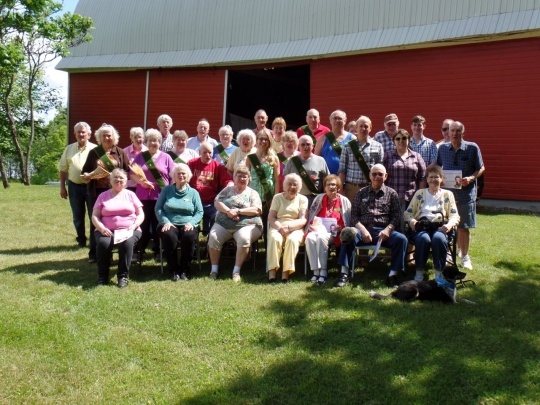
Minnesota Grange Picnic
Minnesota State Grange picnic held on the Sletton Farm in Aitkin on June 13, 2015. Shown are members of Sunbeam Grange #2, Oak Leaf Grange #569, Clear Lake Grange #692, Lake Hubert Grange #735, and Oliver Hudson Kelley Grange #834. Photographed by Alan Champion.
All rights reserved
Holding Location
Articles
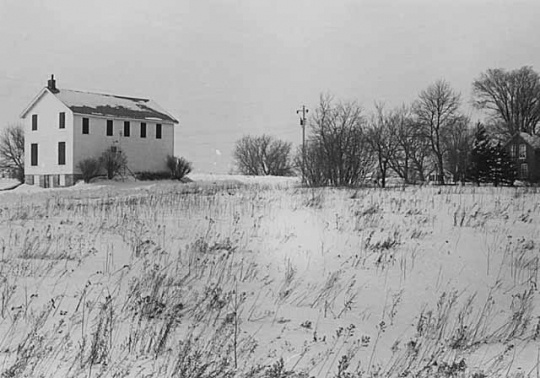
Grange Hall, Pleasant Grove
Grange Hall in Pleasant Grove, 1873.
Public domain
Holding Location
Articles
More Information
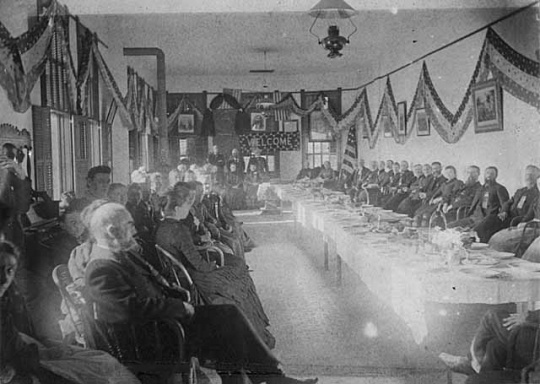
State Grange meeting at Northfield
State Grange meeting at Northfield, c.1875. Photograph by Edward Newell James.
Public domain
Holding Location
More Information
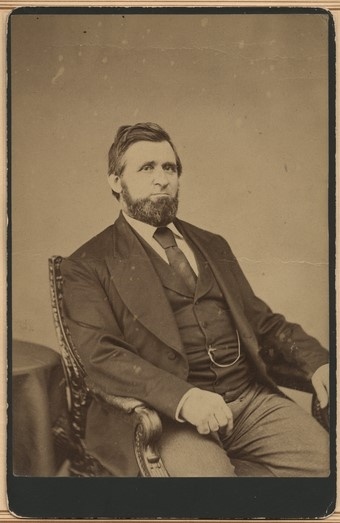
Oliver H. Kelley
Oliver H. Kelley, c.1875.
Public domain
Holding Location
More Information
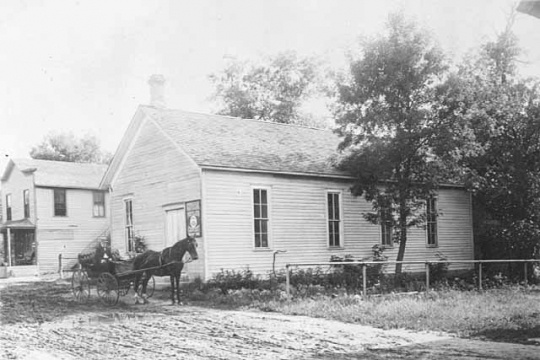
Grange Hall, Bloomington
Grange Hall, Bloomington, c.1890.
Public domain
Holding Location
Articles
More Information
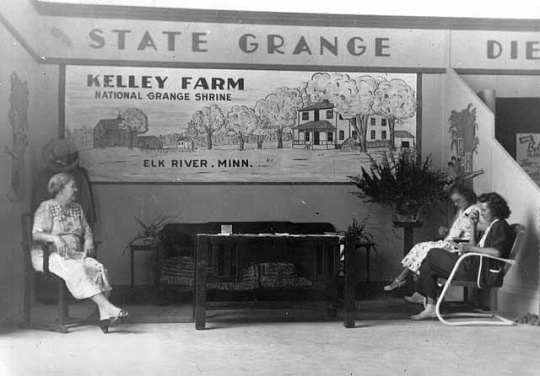
State Grange booth at Minnesota State Fair
State Grange booth at the Minnesota State Fair, c.1948.
Holding Location
Articles
More Information
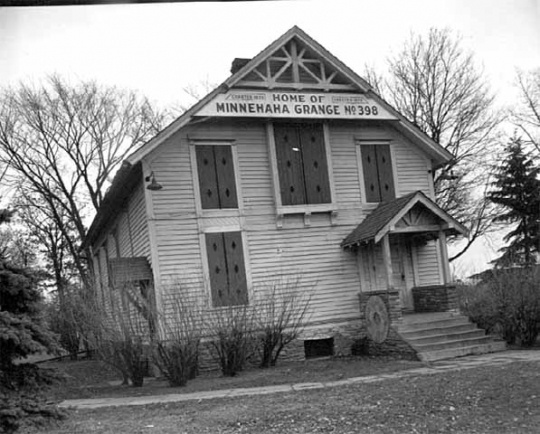
Minnehaha Grange hall
Grange Hall (Minnehaha Grange Number 398) in Edina, 1948.
Holding Location
Articles
More Information
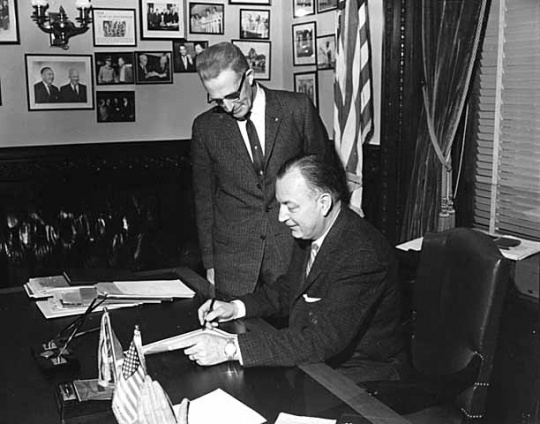
Governor Elmer Benson signing a bill with Grange Master William B. Pearson looking on
Governor Elmer Benson signing a bill with Grange Master William B. Pearson looking on, 1963. Photographed by Eugene Debs Becker.
Holding Location
Articles
More Information
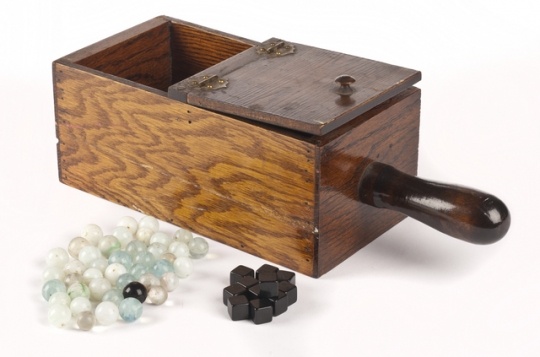
Minnesota Grange ballot box
Wooden ballot box with hinged lid containing forty-two marbles and twelve black plastic cubes. Used by the Minnesota Grange.
All rights reserved
Holding Location
Articles
More Information
Related Articles
Turning Point
In the 1970s, the number of Minnesotans actively and directly engaged in farming decreases. A corresponding decline in the number of local Minnesota Granges eventually forces the creation of a new member-recruitment strategy.
Chronology
December 4, 1867
February 23, 1869
Septem-ber 2, 1873
1888
1893
1929
1935
1960
1992
2003
2013
Bibliography
Davis, C. Jerome. Proud Heritage: The Early Years of the Order of the Patrons of Husbandry. Washington, D.C.: National Grange of the Patrons of Husbandry, 1987.
Gardiner, Charles M. The Grange—Friend of the Farmer: A Concise Reference History of America’s Oldest Farm Organization, and the Only Rural Fraternity in the World, 1867–1947. Washington, D.C.: National Grange, 1949.
Howard, David H. People, Pride and Progress: 125 years of the Grange in America. Washington, D.C.: National Grange, 1992.
Mattson, Ronald Edward. The Minnesota State Grange: Roots of Reform: 1868–1885. Phoenix, AZ: Arizona State University, 1974.
Proceedings of the Granges of Minnesota, 1891–2014
Editor’s Note: These publications are available under multiple library call numbers and are described in multiple catalog records at the Minnesota Historical Society, St. Paul. Copies of individual proceedings are also held by the Minnesota State Grange.
uarc 694
Coates Preston Bull Collection, 1912–1938.
University of Minnesota Libraries, University of Minnesota Archives.
Description: See especially Bull’s pamphlet “History of Relation of Minnesota Grange to School of Agriculture.”
Woods, Thomas A. Knights of the Plow: Oliver H. Kelley and the Origins of the Grange in Republican Ideology. Ames, IA: Iowa State University Press, 1991.
Related Resources
Primary
Braham Minnesota Grange Gleaner, 1935–[1980]
Newspaper Collection, Minnesota Historical Society, St. Paul
Description: A State Grange of Minnesota publication, which was issued monthly.
“Community Grange Organization Application of the Oliver Hudson Kelley Grange.” November 1, 2012.
Diamond Jubilee 1947: State Grange of Minnesota. [St. Paul]: State Grange of Minnesota, 1947.
Donnelly, Ignatius. Facts For the Granges. N.p.: [1873].
The Grange Initiate and Declaration of Purpose of the Order of Patrons of Husbandry. Washington, D.C.: National Grange, [196?].
Grange Records, 1868–1994, (bulk 1910–1966)
Manuscript Collection, Minnesota Historical Society, St. Paul
http://www2.mnhs.org/library/findaids/00155.xml
Description: Records of the Minnesota State Grange.
Grange Records, 1873–1985
Manuscript Collection, Minnesota Historical Society, St. Paul
http://www2.mnhs.org/library/findaids/00152.xml
Description: Records of Minnehaha Grange No. 398.
P540
Grange Records, 1913–1916
Manuscript Collection, Minnesota Historical Society, St. Paul
Description: Minutes and roll book of Ramsey County Grange No. 628, based in Austin.
Minneapolis State Grange Helper, 1884–
Newspaper Collection, Minnesota Historical Society, St. Paul
Description: A quarterly publication of the Minnesota State Grange.
Minnesota State Grange. Agricultural Education in Minnesota: An Open Letter to the Members of the Thirty-second Legislative Assembly of Minnesota. Smithfield, MN: N.p., [1901].
——— . By-Laws of the State Grange of Minnesota and Suggested By-Laws for Subordinate Granges. [MN: N.p., 1929].
——— . By-Laws of the State Grange of Minnesota, Revised to 1913. [MN: N.p., 1913].
——— . By-Laws, Rules of Order, Minnesota State Grange, Patrons of Husbandry. Minneapolis: C.C. Hutchins, 1886.
P2579
Minutes of Meetings, 1868–1883
Manuscript Collection, Minnesota Historical Society, St. Paul
Description: Records of the North Star Grange based in St. Paul.
Red Wing Grange Advance, 1873–1877
http://chroniclingamerica.loc.gov/lccn/sn85025567/
Description: Newspaper covering Goodhue, Freeborn, and Olmsted county news. The newspaper adhered to Populist ideals and published meeting minutes from local Minnesota Granges.
Roster of the Granges of Minnesota, 1933–
Editor’s Note: This publication is available under two separate library catalog records at the Minnesota Historical Society, St. Paul.
Wells, John G. The Grange Illustrated; or Patron’s Handbook. New York: Grange Publishing Co., 1874.
P1831
William B. Pearson Papers, 1911–1987
Manuscript Collection, Minnesota Historical Society, St. Paul
Description: Papers of William B. Pearson who was master of the Minnesota State Grange for thirty years.
Secondary
Bittman, Mark. A Bone to Pick: The Good and Bad News About Food. New York: Pam Kraus Books, 2015.
Crescent Grange 512 Centennial History, 1874–1974. [MN: N.p., 1974].
Demitri, Carolyn, Anne Effland, and Neilson Conklin. “The 20th Century Transformation of US Agriculture and Farm Policy.” United States Department of Agriculture. Economic Information Bulletin 3 (June 2005).
Gilman, Rhoda and Patricia Smith. “Oliver Hudson Kelley: Minnesota Pioneer, 1849–1868.”Minnesota History, 40 no. 7 (Fall 1967): 330–339.
http://collections.mnhs.org/MNHistoryMagazine/articles/40/v40i07p330-338.pdf
Marti, Donald B. Women of the Grange: Mutuality and Sisterhood in Rural America, 1866–1920. New York: Greenwood Press, 1991.
Minnehaha Grange No. 398: Centennial History 1873–1973. Edina, MN: Grange No. 398, n.d.
Minnesota State Demographic Center. Minnesota Now, Then, Who…An Overview of Demographic Change. Power Point prepared for the Capitol Preservation Commission Subcommittee on Art, April, 2015.
Nordin, Sven D. Rich Harvest: A History of the Grange, 1867–1900. Jackson, MS: University of Mississippi, 1974.
Ridge, Martin. “Ignatius Donnelly and the Granger Movement in Minnesota.” Mississippi Valley Historical Review 42, no. 4 (March 1956): 693–709.
Roberts, Kate. Minnesota 150: The People, Places, and Things that Shape Our State. St. Paul: University of Minnesota Press, 2007.
Thorstad, Linda Marie. “The Historical and Cultural Geography of the Grange in Minnesota and Louisiana, 1870–1880.” PhD diss., Louisiana State University, 1999.
Zeller, Mary E. Minnesota State Grange Centennial History. [MN]: Minnesota: State Grange of Minnesota, 1972.
Web
State Grange of Minnesota.
http://www.MNgrange.org/
National Grange: Patrons of Husbandry.
www.NationalGrange.org










